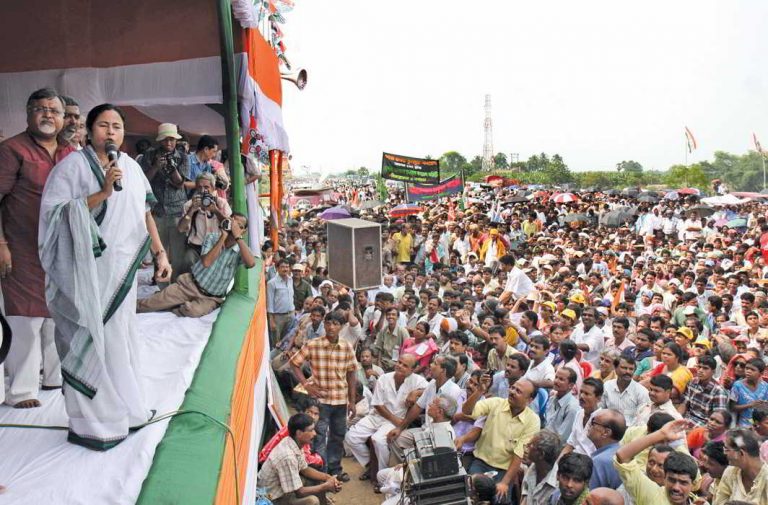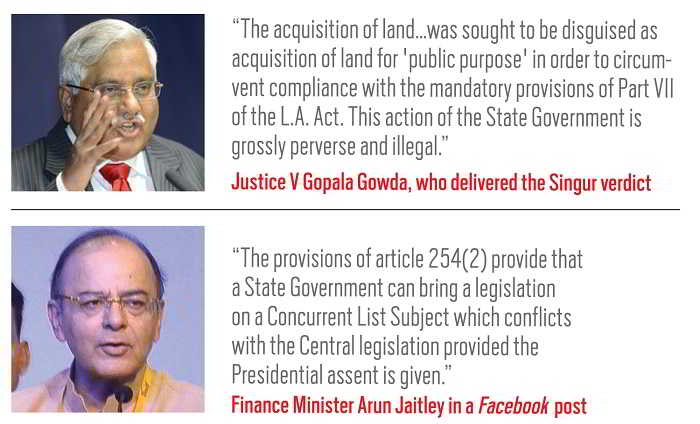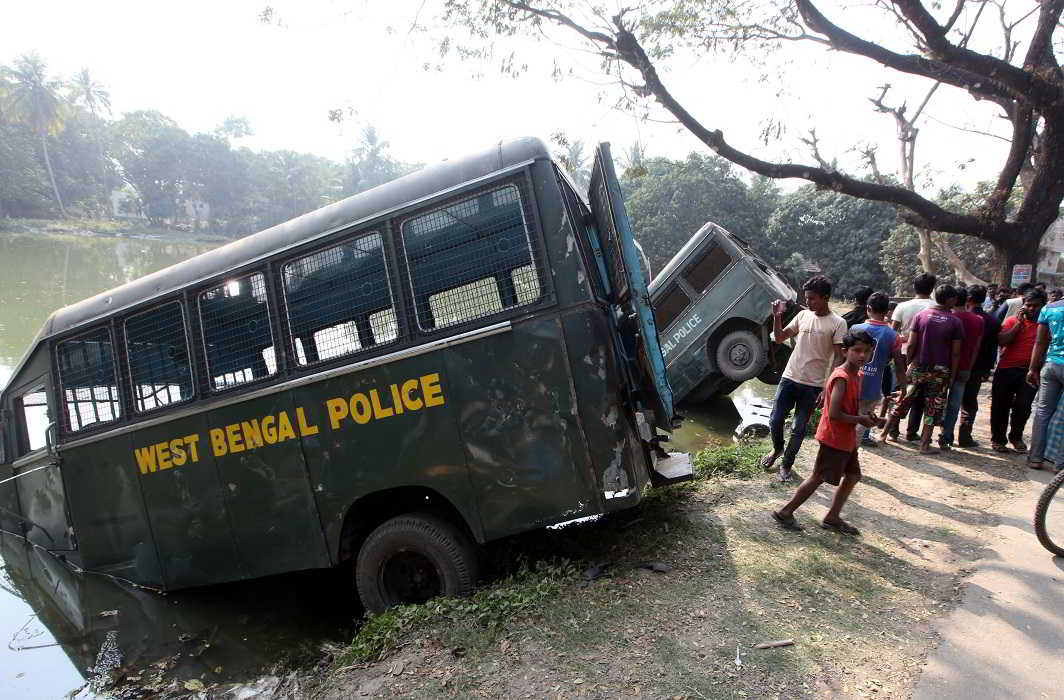
Though the feisty chief minister stopped the Nano plant in West Bengal, she is herself in a bind now over protests regarding a power project in Bhangar. But there are legal solutions to this impasse
~By Sujit Bhar
Singur has come back to haunt West Bengal Chief Minister Mamata Banerjee. On August 31, 2016, the Supreme Court had declared the acquisition of 1,053 acres by the Left Front government for a Nano plant at Singur as illegal. This was something Mamata had been fighting for all along and it helped her win the assembly election.
However, two months later when Mamata tried to set up a power substation in Bhangar in South 24 Parganas district, farmers there protested. In 2013, some 13 acres of their land was acquired but they felt they hadn’t been paid a fair price. They now wanted their land back. As protests spread, at least ten police vehicles were torched and one person died from bullet wounds. Finally, on January 16, 2017, the police arrested Kalu Sheikh, a leader of the agitation. Mamata’s policy of not taking land from farmers for any development project is now creating hurdles in her path.
With the central government allowing its final ordinance on land acquisition to lapse, the original Land Acquisition, Rehabilitation and Resettlement (LARR) Act 2013 is back in place (See box 1). This Act has stringent clauses which make negotiations tedious and time-consuming, requiring project budgets to be revised so often that they become unviable. One clause, for example, says that consent is a must from 70 percent of families whose land is taken for public private partnership (PPP) projects. This could go up to 80 percent for a private project.
Land acquisition in India is governed by the Right to Fair Compensation and Transparency in Land Acquisition, Rehabilitation and Resettlement Act, 2013. Till 2013, land acquisition was governed by the Land Acquisition Act of 1894. The scope of the Act includes land acquisition by the central government and states, except Jammu & Kashmir.
This subject has many legal dimensions.
While acquiring land, these aspects have to be ascertained:
- Issuance of a notification (publication of the same)
- Carrying out a social impact assessment
- Survey of the land to analyse whether it is being acquired for a public purpose or whether there is any alternate land that can be acquired
- Hearing objections with regard to acquisition.
- Rehabilitation has been incorporated in the new Act and procedure for the same has been laid down
- The minimum amount of compensation has been clarified.
Many judgments have come out with regard to these sections.
Notification and Publication: In the Khub Chand vs. State of Rajasthan, the Court held that Section 4(1) of the Land Acquisition Act, 1894 clearly suggests that the requirement is a mandatory one. This can become important if such notification was missing in the Bhangar case.
In Habib Ahmed vs. State of Uttar Pradesh, the Court held that neither the notification nor the declaration can be quashed on the ground that there was no necessity for acquiring the land for a public purpose. Whether the land is required for a public purpose or not has to be decided solely by the state government.
Payment for Damages: Section 13 provides that the officer shall at the time of entry into the land in question pay for any damage caused. Damage means any harm done to the land during the course of surveying it and other acts necessary to ascertain whether it is capable of being adapted for public purposes.
Hearing objections: Section 15(1) provides that any person interested in any land which has been notified as being required or likely to be required for a public purpose, may within 60 days from the date of the publication of the preliminary notification, object to: (a) The area and suitability of land proposed to be acquired; (b) Justification offered for public purpose; (c) The findings of the Social Impact Assessment report.
Rehabilitation and Resettlement: Section 16 provides for the preparation of a Rehabilitation and Resettlement Scheme by the administrator. How much of this was prepared and provided will have to be settled first.
–By Navank Shekhar Mishra and Sandeep Kumar
In fact, the Supreme Court too would prefer to stick to this Act as can be seen from the observations of Justice V Gopala Gowda, one of the judges who delivered the Singur verdict. Justice Gowda had said: “The acquisition of land…was sought to be disguised as acquisition of land for ‘public purpose’ in order to circumvent compliance with the mandatory provisions of Part VII of the L.A. Act. This action of the State Government is grossly perverse and illegal and void ab initio in law and such an exercise of power by the state government for acquisition of lands cannot be allowed under any circumstance.”
 With regard to compensation, he had said: “A joint inquiry appears to have been conducted by the Land Acquisition Collector without giving them (farmers) an adequate opportunity to establish their claim for determination of reasonable compensation for acquisition of lands by presenting true and correct market value of the lands.”
With regard to compensation, he had said: “A joint inquiry appears to have been conducted by the Land Acquisition Collector without giving them (farmers) an adequate opportunity to establish their claim for determination of reasonable compensation for acquisition of lands by presenting true and correct market value of the lands.”
This judgment has given a fillip to the farmers’ demands. According to the Act in force now, it will be the market value “multiplied by a factor of, at least one to two times… for land acquired in rural areas and at least one time the market value for land acquired in urban areas”. Plus, “a solatium equal to 100 percent of the market value of the property including value of assets” will have to be paid.
Two other options exist for the Mamata government to make land acquisition easy and in line with her stated policies:
Land Pooling: Land pooling came into effect around the time of the Green Revolution when farmers voluntarily did away with their small tracts of land and yielded to large contiguous plots. This enabled mechanised farming and gave large yields, benefitting all stakeholders.
Here, the government may purchase or acquire more land than it needs for a major project, develop the project in time and return a fraction of the land purchased/acquired to the original owners. Once a big project comes up in a neighbourhood, the costs of the returned land would appreciate more than the larger portion.
However, this also depends heavily on employment opportunities available from this project because the fraction of the land returned may not be suitable for farming any more.
Lease Option: The long-term lease option will not only yield regular income to the landowner but also allow him to renegotiate terms after completion of the lease period. However, that could present a legal minefield for the government and time could be lost in negotiation.
This has left Mamata in a quandary over Bhangar. What is the way out? Ironically, Finance Minister Arun Jaitley, provided the answer in a Facebook post, where he said: “Acquisition of property is a List-III, Entry 42 subject provided for in the Concurrent List. The provisions of article 254(2) clearly provide that a State Government can bring a legislation on a Concurrent List Subject which conflicts with the Central legislation provided the presidential assent is given….States are thus fully empowered to amend the 2013 Land Law….”

Tamil Nadu took this route for land acquisition in 2013 and enforced it from January 5, 2015. It inserted a new section (105A), thereby adding a Fifth Schedule to the existing four in the 2013 Act and thus exempting it from the provisions of the Act. This amendment allows the Tamil Nadu government to apply the compensation, rehabilitation and resettlement provisions of the 2013 Act to the listed legislations in its own way. It also allows the state to add or delete legislations in the Fifth Schedule as conditions change. Hence, compensation rates could also change.
Two other states—Rajasthan and Madhya Pradesh—have also followed this route to amend many labour laws that fall under the Concurrent List. This is a path that Mamata could explore.
However, even in trying to pass an ordinance, she could get caught in her own policy net—not to acquire land from unwilling farmers. This has resulted in the acquisition of small, fractured plots that are not contiguous and hence, unsuitable for large industries. Due to this, many large investments have died prematurely.
Mamata, it seems, is caught between a rock and a hard place.
Lead picture: Mamata Banerjee at a Singur rally, one of few that formed the plinth of her political agitations in West Bengal

